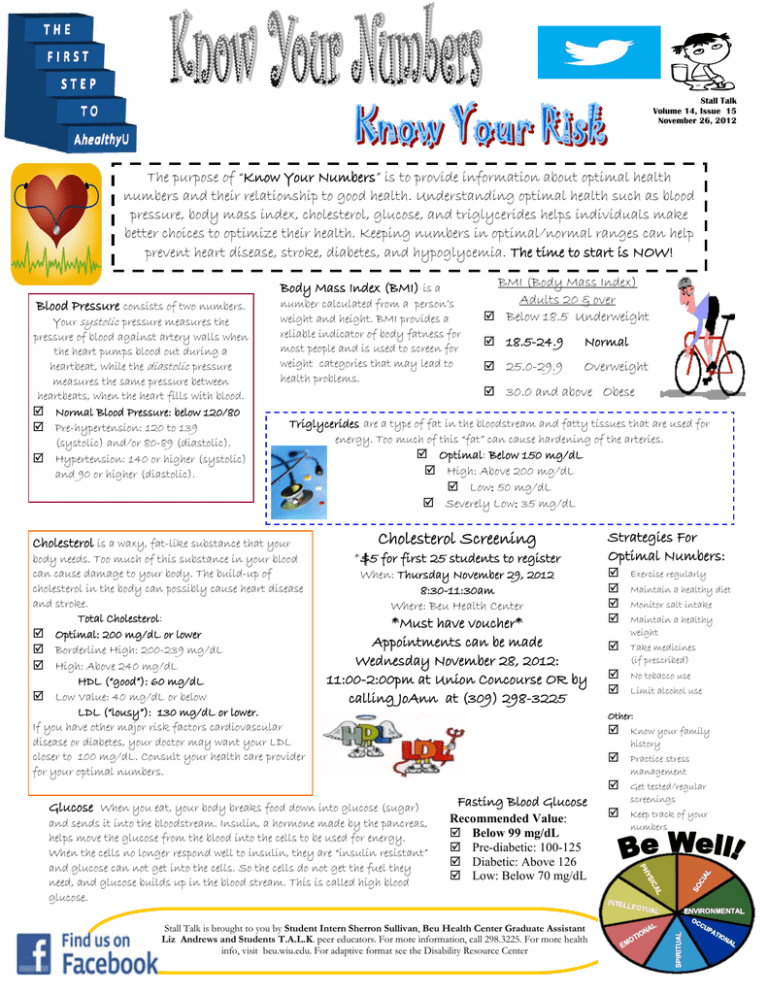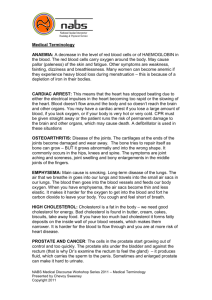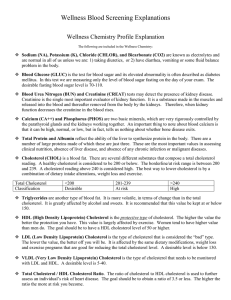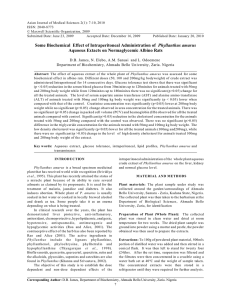Document 10745892
advertisement

Stall Talk Volume 14, Issue 15 November 26, 2012 The purpose of “Know Your Numbers” is to provide information about optimal health numbers and their relationship to good health. Understanding optimal health such as blood pressure, body mass index, cholesterol, glucose, and triglycerides helps individuals make better choices to optimize their health. Keeping numbers in optimal/normal ranges can help prevent heart disease, stroke, diabetes, and hypoglycemia. The time to start is NOW! Body Mass Index (BMI) is a Blood Pressure consists of two numbers. Your systolic pressure measures the pressure of blood against artery walls when the heart pumps blood out during a heartbeat, while the diastolic pressure measures the same pressure between heartbeats, when the heart fills with blood. Normal Blood Pressure: below 120/80 Pre-hypertension: 120 to 139 (systolic) and/or 80-89 (diastolic). Hypertension: 140 or higher (systolic) and 90 or higher (diastolic). number calculated from a person’s weight and height. BMI provides a reliable indicator of body fatness for most people and is used to screen for weight categories that may lead to health problems. BMI (Body Mass Index) Adults 20 & over Below 18.5 Underweight 18.5-24.9 Normal 25.0-29.9 Overweight 30.0 and above Obese Triglycerides are a type of fat in the bloodstream and fatty tissues that are used for energy. Too much of this “fat” can cause hardening of the arteries. Optimal: Below 150 mg/dL High: Above 200 mg/dL Low: 50 mg/dL Severely Low: 35 mg/dL Cholesterol is a waxy, fat-like substance that your body needs. Too much of this substance in your blood can cause damage to your body. The build-up of cholesterol in the body can possibly cause heart disease and stroke. Total Cholesterol: Optimal: 200 mg/dL or lower Borderline High: 200-239 mg/dL High: Above 240 mg/dL HDL (“good”): 60 mg/dL Low Value: 40 mg/dL or below LDL (“lousy”): 130 mg/dL or lower. If you have other major risk factors cardiovascular disease or diabetes, your doctor may want your LDL closer to 100 mg/dL. Consult your health care provider for your optimal numbers. Cholesterol Screening *$5 for first 25 students to register When: Thursday November 29, 2012 8:30-11:30am Where: Beu Health Center *Must have voucher* Appointments can be made Wednesday November 28, 2012: 11:00-2:00pm at Union Concourse OR by calling JoAnn at (309) 298-3225 Strategies For Optimal Numbers: Exercise regularly Maintain a healthy diet Monitor salt intake Maintain a healthy weight Take medicines (if prescribed) No tobacco use Limit alcohol use Other: Know your family history Practice stress management Get tested/regular CI AL AL Stall Talk is brought to you by Student Intern Sherron Sullivan, Beu Health Center Graduate Assistant Liz Andrews and Students T.A.L.K. peer educators. For more information, call 298.3225. For more health info, visit beu.wiu.edu. For adaptive format see the Disability Resource Center numbers SO Recommended Value: Below 99 mg/dL Pre-diabetic: 100-125 Diabetic: Above 126 Low: Below 70 mg/dL screenings Keep track of your IC YS PH and sends it into the bloodstream. Insulin, a hormone made by the pancreas, helps move the glucose from the blood into the cells to be used for energy. When the cells no longer respond well to insulin, they are “insulin resistant” and glucose can not get into the cells. So the cells do not get the fuel they need, and glucose builds up in the blood stream. This is called high blood glucose. Fasting Blood Glucose INTEL LECTU AL O EM L NA TIO ENVIRONMENT AL SPIRITUAL Glucose When you eat, your body breaks food down into glucose (sugar) OC CU PA TIO NA L






